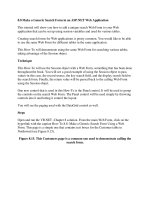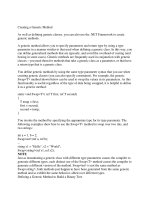Tài liệu Creating a Generic Method pdf
Bạn đang xem bản rút gọn của tài liệu. Xem và tải ngay bản đầy đủ của tài liệu tại đây (21.37 KB, 4 trang )
Creating a Generic Method
As well as defining generic classes, you can also use the .NET Framework to create
generic methods.
A generic method allows you to specify parameters and return type by using a type
parameter in a manner similar to that used when defining a generic class. In this way, you
can define generalized methods that are typesafe, and avoid the overhead of casting (and
boxing in some cases). Generic methods are frequently used in conjunction with generic
classes—you need them for methods that take a generic class as a parameter, or that have
a return type that is a generic class.
You define generic methods by using the same type parameter syntax that you use when
creating generic classes (you can also specify constraints). For example, the generic
Swap<T> method shown below can be used to swap the values in its parameters. As this
functionality is useful regardless of the type of data being swapped, it is helpful to define
it as a generic method:
static void Swap<T>( ref T first, ref T second)
{
T temp = first;
first = second;
second = temp;
}
You invoke the method by specifying the appropriate type for its type parameter. The
following examples show how to use the Swap<T> method to swap over two ints, and
two strings:
int a = 1, b = 2;
Swap<int>(ref a, ref b);
...
string s1 = "Hello", s2 = "World";
Swap<string>(ref s1, ref s2);
NOTE
Just as instantiating a generic class with different type parameters causes the compiler to
generate different types, each distinct use of the Swap<T> method causes the compiler to
generate a different version of the method. Swap<int> is not the same method as
Swap<string>; both methods just happen to have been generated from the same generic
method and so exhibit the same behavior, albeit over different types.
Defining a Generic Method to Build a Binary Tree
The previous exercise showed you how to create a generic class for implementing a
binary tree. The Tree<T> class provides the Insert method for adding data items to the
tree. However, if you want to add a large number of items, repeated calls to the Insert
method are not very convenient. In the following exercise, you will define a generic
method called BuildTree that allows you to create a new binary tree from a list of data
items. You will test this method by using it to construct a tree of characters.
Write the BuildTree method
1. Using Visual Studio 2005, create a new project by using the Console Application
template. In the New Project dialog box, name the project BuildTree and set the
Location to \Microsoft Press\Visual CSharp Step By Step\Chapter 17. Select
Create a new Solution from the Solution dropdown.
2. On the Project menu, click Add Reference. In the Add Reference dialog box click
the Browse tab. Navigate to the folder \Microsoft Press\Visual CSharp Step By
Step\Chapter 17\BinaryTree\bin\Debug, click BinaryTree.dll, and then click OK.
The BinaryTree assembly will be added to the list of references shown in the
Solution Explorer.
3. In the Code and Text Editor window, add the following using directive to the top
of the Program.cs file:
using BinaryTree;
This namespace contains the Tree<T> class.
4. Add a method called BuildTree method to the Program class. This should be a
static method that takes a params array of T elements called data, and returns a
Tree<T> object.
The method definition should look like this:
static Tree<T> BuildTree<T>(params T[] data)
{
}
NOTE
The params keyword was described in detail in Chapter 11, “Understanding
Parameter Arrays.”
5. The T type used for building the binary tree must implement the IComparable<T>
interface. Modify the definition of the BuildTree method and add the appropriate
where clause.
The updated definition of the method should look like this:
static Tree<T> BuildTree<T>(params T[] data) where T : IComparable<T>
{
}
6. Add the statements shown below to the BuildTree method. These statements
instantiate a new Tree object by using the appropriate type parameter, and then
iterate through the params list, adding each item to the tree by using the Insert
method.
The tree is passed back as the return value:
static Tree<T> BuildTree<T>(params T[] data) where T : IComparable<T>
{
Tree<T> sortTree = new Tree<T> (data[0]);
for (int i = 1; i < data.Length; i++)
{
sortTree.Insert(data[i]);
}
return sortTree;
}
Test the BuildTree method
1. In the Main method of the Program class, add the following statements that create
a new Tree for holding character data, populates it with some sample data by using
the BuildTree method, and then displays it by using the WalkTree method of the
Tree:
2. Tree<char> charTree = BuildTree<char>('Z', 'X', 'A', 'M', 'Z', 'M', 'N');
charTree.WalkTree();
3. On the Build menu, click Build Solution. Verify that the solution compiles,
correcting any errors if necessary.
4. On the Debug menu, click Start Without Debugging.
When the program runs, the character values will be displayed, in order:
A, M, M, N, X, Z, Z
5. Press the Enter key to return to Visual Studio 2005.
•
If you want to continue to the next chapter
Keep Visual Studio 2005 running and turn to Chapter 18.
•
If you want to exit Visual Studio 2005 now
On the File menu, click Exit. If you see a Save dialog box, click Yes.









